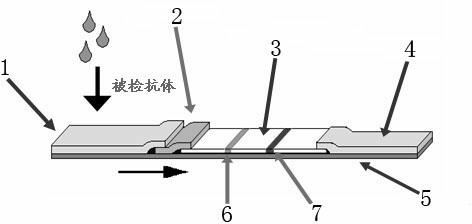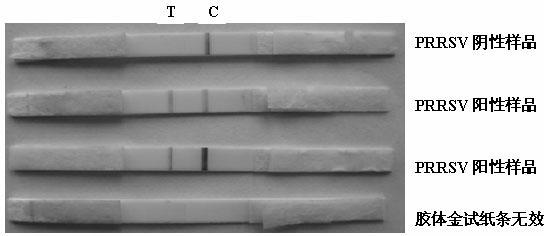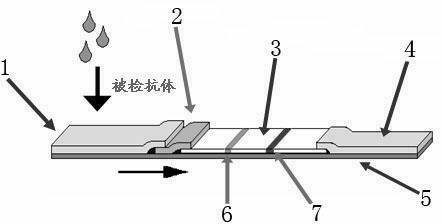Colloidal gold quick diagnosis test paper for distinguishing classic porcine reproductive and respiratory syndrome (PRRS) from highly pathogenic PRRS (HPRRS)
A rapid diagnosis, colloidal gold technology, applied in the direction of measuring devices, instruments, scientific instruments, etc., can solve the limitations of the prevention and control of porcine PRRS, high detection costs, inconvenient real-time and rapid differential diagnosis of classic porcine PRRS and high pathogenicity To solve the problems of pig blue-ear disease and other problems, achieve the effect of low production cost, low detection cost, and improve sensitivity and specificity
- Summary
- Abstract
- Description
- Claims
- Application Information
AI Technical Summary
Problems solved by technology
Method used
Image
Examples
Embodiment 1
[0019] Example 1 Preparation of Immunogen
[0020] The deletion of 30 amino acids in Nsp2 has become an important index for distinguishing highly pathogenic PRRS from classical PRRS. In this experiment, 30 amino acids of the PRRS Nsp2 region as an antigen were synthesized by the company's synthetic method and coupled with the BSA carrier to prepare the immunogen.
Embodiment 2
[0021] Example 2 Preparation of anti-classic PRRS monoclonal antibody
[0022] 1. For animal immunization, select healthy Balb / c mice aged 6-8 weeks, and inject about 50 μg of the immunogen emulsified with Freund's complete adjuvant into the abdominal cavity of each mouse, and emulsify the immunogen protein with Freund's incomplete adjuvant 14 days later 100 μg was injected intraperitoneally, and 100 μg of purified immunogenic protein was injected intraperitoneally directly at the last booster immunization, and 50 μg of purified immunogenic protein was injected into the tail vein 3 to 4 days before fusion.
[0023] 2. Cell fusion Take the splenocytes of immunized mice and mix them with SP2 / 0 in the fusion tube, centrifuge at 300g for 10min, discard the supernatant, shake the cells to mix the two kinds of cells as evenly as possible, and then add the preheated solution slowly within 45s. PEG solution, then slowly add serum-free 1640 medium to stop the fusion, let stand and th...
Embodiment 3
[0032] Example 3 Preparation of colloidal gold and gold-labeled antigen
[0033] 1. Preparation of colloidal gold:
[0034] Dilute 1% chloroauric acid to 0.01% with double-distilled deionized water, heat to boil, add 2ml 1% sodium citrate for every 100ml 0.01% chloroauric acid, continue to boil until the liquid is bright red, then stop heating, cool to Rehydrate at room temperature. The appearance of the prepared colloidal gold should be pure, translucent, free of precipitation and floating matter.
[0035] 2. Preparation of colloidal gold-labeled classic PRRS specific antigen:
[0036] Use 0.1M potassium carbonate to adjust the pH value of the colloidal gold to 8.2, add the classic PRRS specific antigen at 100ug antibody / ml colloidal gold, mix with a magnetic stirrer for 30 minutes, add BSA to a final concentration of 1%, and let it stand for 1 hour. Centrifuge at 13000rpm at 4°C for 30 minutes, discard the supernatant, wash the precipitate twice with the labeled washing...
PUM
| Property | Measurement | Unit |
|---|---|---|
| diameter | aaaaa | aaaaa |
Abstract
Description
Claims
Application Information
 Login to View More
Login to View More - R&D
- Intellectual Property
- Life Sciences
- Materials
- Tech Scout
- Unparalleled Data Quality
- Higher Quality Content
- 60% Fewer Hallucinations
Browse by: Latest US Patents, China's latest patents, Technical Efficacy Thesaurus, Application Domain, Technology Topic, Popular Technical Reports.
© 2025 PatSnap. All rights reserved.Legal|Privacy policy|Modern Slavery Act Transparency Statement|Sitemap|About US| Contact US: help@patsnap.com



